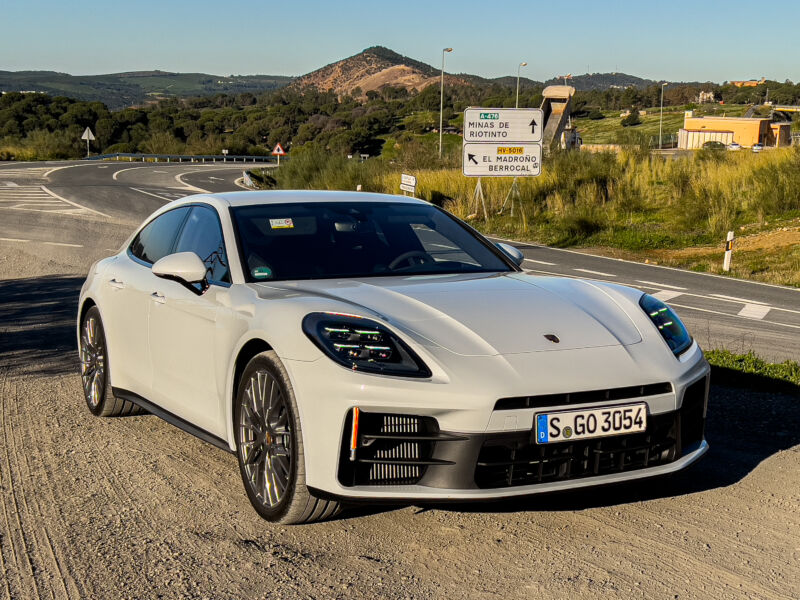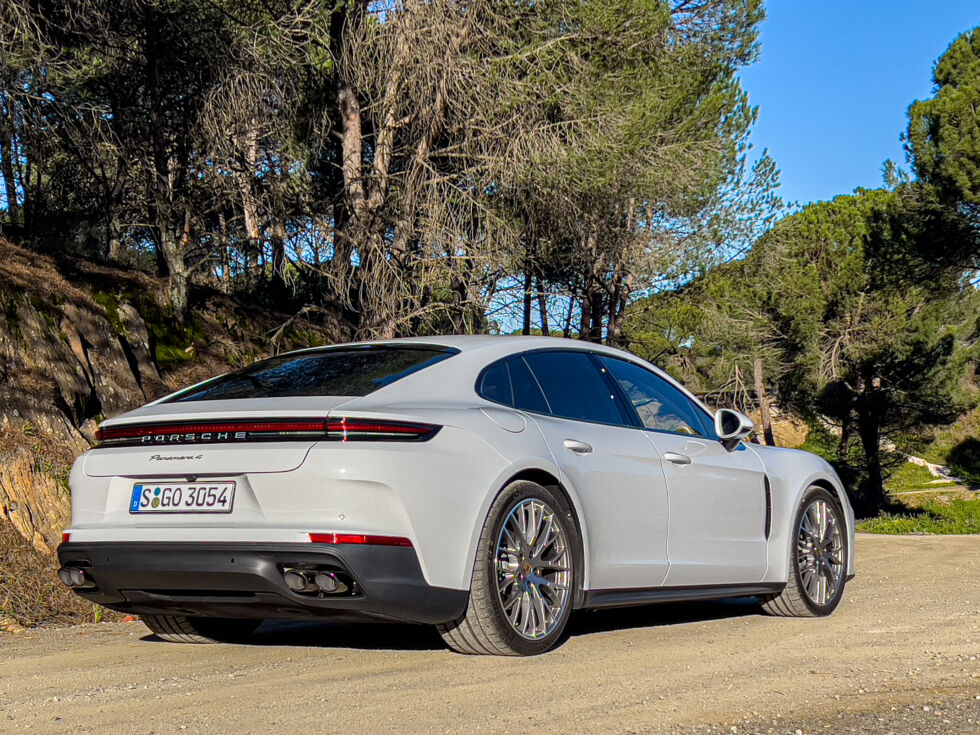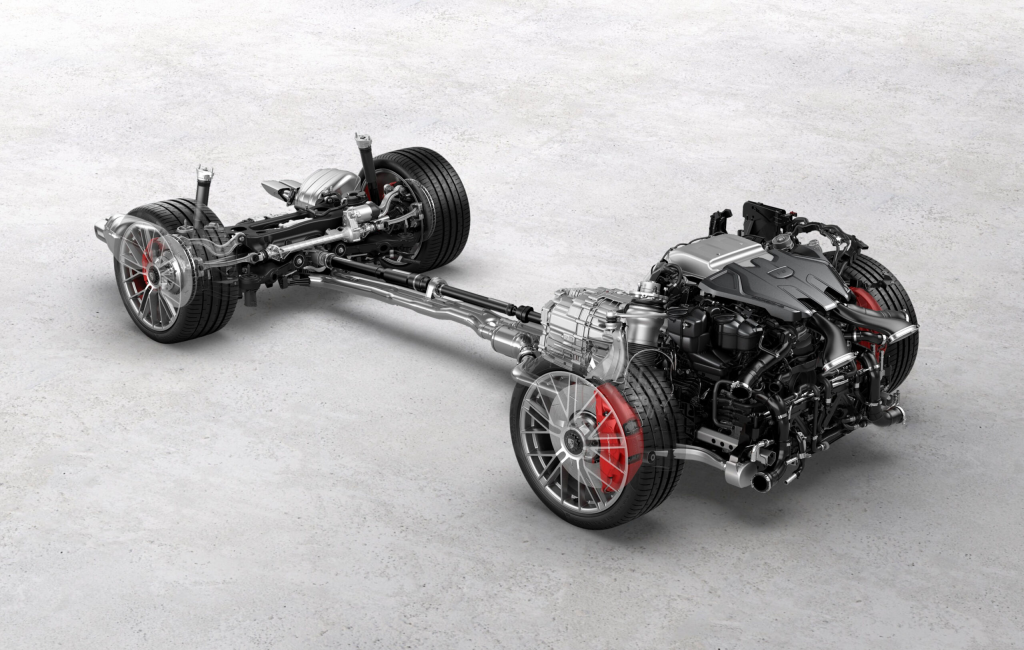There’s clever new air suspension and a much bigger battery for the PHEV variant.

SEVILLE, Spain—Once upon a time, Porsche just made two-door sports cars. Then the 21st century happened. People started to get fickle and demand things like practicality and comfort as well as good handling and soild engineering. Preferring to stay in business, Porsche recognized this market shift and since 2003 has bolstered its lineup, first with SUVs, then in 2009 with the Panamera sedan.
That sedan is now in its third generation, and late last year, we visited its factory in Leipzig to get a sneak preview of the prototype. Now, the new Panamera has gone into production, and we spent a day driving a pair of models on the road and track ahead of the car’s arrival in the US this summer.
Looks-wise, the third-gen Panamera closely resembles the outgoing model to the extent that it has the exact same exterior measurements: 198.8 inches (5,052 mm) long, 76.3 inches (1,937 mm) wide, and 56 inches (1,423 mm) tall. However, it will only be offered as a five-door hatchback—the Sport Turismo variant is no more, we’re told.

The design looks a bit sharper than the older car’s, with more pronounced fenders over the wheel and steeply raked LED matrix headlights. At the back, the retractable rear wing is a split-piece affair that pops out and then extends above a certain speed threshold. Keen eyes will also see additional air ducts at the front to better cool the engine bay.
Powertrains
The Panamera was the first Porsche to sport a hybrid powertrain, ignoring, of course, the Lohner-Porsche Semper Vivus of 1899. In 2016, Porsche put a plug-in hybrid powertain into the Panamera for the first time, and it will eventually offer a total of four different PHEV powertrains for the 4th-gen car. It’s only offering one at launch, though, and it’s the Panamera Turbo E-Hybrid. You’ll know you’re looking at a Panamera Turbo because of the distinctive “Turbonite” colored badge and accents, and pedants will be pleased to know that this car does indeed feature forced induction.Advertisement
In fact, the 4.0 L V8 uses a pair of turbochargers, now monoscroll, rather than the twin-scroll turbines in the old car. This allows the car to heat the catalytic converter more quickly and operate at higher exhaust gas temperatures. There’s no more cylinder deactivation; instead, Porsche’s engineers have used variable valve lift and opening to cope with different engine loads.
There’s an all-new 188-hp (140 kW), 332 lb-ft (450 Nm) electric motor for the PHEV powertrain, which now lives inside the eight-speed dual clutch PDK transmission (which powers all four wheels) rather than downstream of it. Total power and torque output is 670 hp (500 kW) and 685 lb-ft (935 Nm).
- A cutaway illustration of the Panamera Turbo E-Hybrid’s powertrain. Porsche
- A cutaway illustration of the Panamera plug-in hybrid battery pack. Porsche
- A cutaway showing the internals of the Panamera Turbo Hybrid’s PDK transmission. Note the electric motor on the far left. Jonathan Gitlin

The electric motor is always coupled to the transmission, and it’s only when the car wants to add some internal combustion power that a decoupler closes and engages the V8 as well. Under braking, the electric motor can regenerate up to 88 kW before the friction brakes take over. Top speed is 87 mph (140 km/h) under electric power alone, or 190 mph (305 km/h) with the V8 also contributing.
There’s also a new high-voltage traction battery to go with the new electric motor. Porsche has upped the capacity to 25.9 kWh, which should translate to a meaningful increase in the distance one can drive on electric power alone. Porsche has yet to release official EPA fuel efficiency data, so we can’t be specific, but the European WLTP electric-only range is between 76 and 91 km, depending on drive mode, which is about a 75 percent improvement on the previous Panamera PHEV. Recharge times (from 0 to 100 percent) are as low as 2 hours and 39 minutes via the onboard 11 kW AC charger.
The other two powertrains at launch will be the rear-wheel drive Panamera and the all-wheel drive Panamera 4. Both use a 2.9 L twin-turbo V6 gasoline engine, which generates 349 hp (260 kW) and 368 lb-ft (500 Nm), a 10 percent increase in both stats over the outgoing V6 Panamera. Coupled with a new eight-speed PDK transmission, that saves a tenth of a second or two on the 0–60 time—between 4.8 and 5 seconds depending on whether you optioned the Sport Chrono package—and raises the top speed to 168 mph (270 km/h) for the Panamera and 169 mph (272 km/h) for the Panamera 4.
ARS VIDEO
How Scientists Respond to Science Deniers
Suspension
Porsche is fitting the Panamera with two-chamber, two-valve air suspension as standard, replacing the three-chamber, single-valve setup in the old model. This offers meaningful improvements in handling, ride comfort, and ride isolation, as well as better resisting pitch and roll.
- We weren’t able to drive the Turbo E-Hybrid on the street, but we did exercise it on track. Porsche
- Despite weighing more than two tons, it coped with track work admirably. Porsche
- The Michelin Pilot Sport 5S tires were quite loud as they reached their limit. Porsche

The hybrid Panameras, including the Turbo E-Hybrid we tested, can be specced with Porsche Active Ride, which uses two-valve dampers but only a single air chamber. The hybrid powertrain is necessary to supply the hydraulic system with 400 V, and the dampers can actuate up to 2,204 lbs (1,000 kg) in rebound and compression in less than 50 ms, responding at 13 Hz. The system also allows Porsche to do away with antiroll bars, which enhance handling at the cost of ride comfort.
Active Ride behaves differently depending on the drive mode you’re in. In Sport Plus, it dynamically lowers the car at speed and even more under braking, decreasing wheel camber at the same time. The camber increases as you turn into a corner, and the ride height increases as you accelerate down a straight.
Things get a little weirder in Normal mode with Active Ride, although only if you enable particular settings. One of these is active cornering, which leans the car into a corner the same way a motorcycle rider might. (In a passive car, weight transfer means it would lean out of the corner instead.)Advertisement
This is a rather extreme demonstration of the active ride’s articulation. Porsche wrote an iPhone app that uses the phone’s gyroscope and accelerometers as a controller, but it has no plans to let that app out into the wild for users to play with.
Stranger still is what happens under braking and acceleration, where the active suspension does the opposite of what a car normally does. Under braking, the nose rises, and under acceleration, the back raises up. All three of these functions counteract the normal weight transfer in those situations, decreasing lateral or longitudinal acceleration on the passengers.
You really notice the effect when it’s turned on and you’re driving quickly, and it can feel a little unnatural as the car pitches up under braking. But for day-to-day driving on the street, it’s only really perceptible as a smoother ride, ideally suiting the Panamera’s role as a luxury car. People will probably appreciate the way the suspension can raise up to its maximum height to aid entry and egress, although, like the active features, this can be disabled in the settings.
How does it drive?
Perhaps the most noticeable change from the second- to third-gen Panameras is how well Porsche’s engineers have hidden the car’s mass. The Turbo E-Hybrid tips the scales at 5,203 lbs (2,360 kg), with the Panamera 4 shedding about 1,000 lbs (454 kg) of that, so it’s hardly a lightweight machine. In the old car, you felt each one of those pounds, particularly when turning into a corner. But the new car’s power steering and air suspension act like virtual weight watchers, allowing you to turn in with a nimbleness you don’t expect.
Porsche only let us drive the Panamera 4 on the roads around Seville, where it proved not particularly fast but very comfortable, particularly from the passenger seat. It’s still a rather wide car, which made some of the narrow hill roads a little challenging, and there’s a lot of tire roar on the highway. It cruises well on the highway, and the PDK transmission decouples the engine when you want to glide off-throttle, aided by the 0.28 drag coefficient.Advertisement
- Porsche set out to build a luxury car with the Panamera, not a sports car, and it succeeded. Porsche
- The Panamera’s interior. Jonathan Gitlin
- The main instrument display is an all-digital affair, like the Porsche Taycan. Porsche
- Happily, there are buttons for the HVAC. Porsche
- A look at the rear seats. Porsche
- There’s 17.5 cubic feet (494 L) of cargo volume with the seats in use or 46.9 cubic feet (1,328 L) if you fold them flat. Porsche
- Centerlocking wheels are an option, as are electric green highlights for the brake calipers if it’s a hybrid model. Jonathan Gitlin
- Alternatively, the Turbo can be specced with these Turbonite alloys. Jonathan Gitlin

For the Turbo E-Hybrid, we were confined to the track—in this case, the Monteblanco circuit, which had an interesting mix of technical corners upon which the Panamera could strut its stuff. It was an easy car to drive hard on track, with good turn-in and a tendency to understeer once you pass the tire’s limits of adhesion. It was easy to hustle through the circuit’s tight left-right chicane, and the brake pedal offered good feel despite being a brake-by-wire device rather than simply hydraulic.
A word on those tires—the new Panamera comes shod in Michelin’s new Pilot Sport 5S, which offers prodigious amounts of grip considering it’s not an ultra-high performance track tire. They’re pretty hard-wearing, too—by the time Ars and our fellow American journalists got track time in the Panameras, they had already completed two days of track action with journos from other regions, yet the cars were all still running the same tires they started the week on. (I was also very impressed with their performance on wet and greasy roads when we briefly drove the prototype in 2023.)
The model year 2025 Panameras will go on sale in the US this summer, and Porsche will release pricing and fuel-efficiency data sometime in April.




